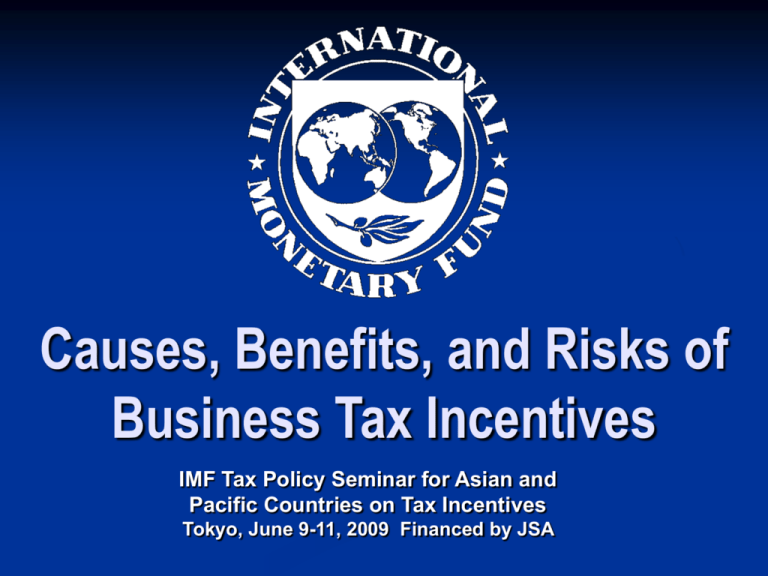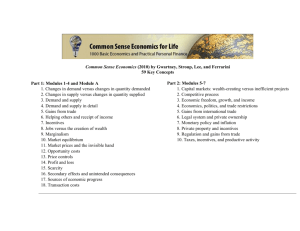An Overview of Tax Incentives
advertisement

Causes, Benefits, and Risks of Business Tax Incentives IMF Tax Policy Seminar for Asian and Pacific Countries on Tax Incentives Tokyo, June 9-11, 2009 Financed by JSA Today’s presentation “Views are my own and do not necessarily represent those of the IMF” 2 An overview of tax incentives Empirical evidence on tax incentives An Overview of Tax Incentives 3 Introduction Tax incentives are controversial: Economists generally skeptical But remain popular, especially in developing countries Is there a need to reconsider/reinforce advice? At least more research needed! 4 Definition “Any measure that provides for a more favorable tax treatment of certain activities or sectors compared to what is available to general industry.” Alternative definitions exist, but not practicable Implication: 5 Tax cuts / generally available depreciation schemes not considered tax incentives. Typical incentives 6 Tax holidays Special zones Investment tax credits / allowances Accelerated depreciation Reduced tax rates Exemptions from various taxes Financing incentives … Reasons for tax incentives Address externalities Regional development Political economy Tax competition 7 Doing something Fragmented policy making … Incentives allow differentiation between more and less mobile capital Tax competition Countries attempt to attract capital or taxable profits, by reducing taxes on capital Theoretical result: small open economies should not levy source-based capital income taxes But: 8 Capital imperfectly mobile Tax system complicated (bases, rates, incentives) Economic rents – location- or company-specific Economic rents Location-specific, e.g., natural resources. Regional, e.g., scenery. Regional cooperation, however, could allow taxation without capital leaving the regions. Firm-specific, e.g., patents. 9 Such rents can be taxed and there should be no interaction with other governments. a positive rent (present discounted value (PDV) net of tax) should be enough for an investment to be worthwhile. Such rents are subject to full tax competition. Even if a project's PDV for a discrete investment project remains positive after taxation, investment will not take place, if after-tax PDV higher in another country. Complexity of tax system Tax incentives permit countries to discriminate between more and less mobile capital Other reforms may also achieve this 10 This may even be beneficial (Keen 2002, Janeba and Smart 2003) Base-broadening rate-cutting Intermediate conclusions Tax incentives appear rational response to tax competition Does not mean they are best response Even incentives with domestic intent, can lead to tax competition 11 Need to consider details of the costs and benefits of tax the different incentives Evaluation of tax incentives Costs Revenue forgone Nil if only apply to new activity and no crowding out Full, if no new net activity Administrative/compliance costs Rent-seeking behavior/corruption Distortions (unless desired) → Very hard to assess 12 Evaluation of tax incentives Benefits Additional investment/growth (but what is counterfactual?) Better quality of investment Externalities reduced → Even harder to assess 13 Cost-benefit analysis Partial equilibrium approach can be very misleading: A study of an incentive reveals that x new plants were set up, which would not have occurred otherwise But other investment possibly crowded out As usual (infrastructure limits, labor market, etc.) Additionally: Because of higher taxes needed on other industry 14 Cannot always be calculated, but needs to be mentioned Principles for choosing tax incentives General principles for good tax policy Transparency / simplicity Include in tax laws Predictability Rules rather than discretion Enforceability / robustness to evasion Economic efficiency? Equity? 15 Tax holidays Very popular Particularly harmful Most attractive to short-term, footloose, rapidly profitable investment Unknown cost Encourage rent-seeking behavior (renewals) 16 Possible, but difficult, to make theoretical case Investment allowances Same effect as investment tax credits (algebra) Directly contingent on investment Distort choice of capital goods 17 Short rather than long-lived capital Physical rather than financial or intangible capital Useful only to profitable businesses (unless refundable)… … but not very valuable to most profitable ones Accelerated depreciation Similar impact as allowances/tax credits But more limited: Timing advantage only Time-value of money Help for cash-constrained, but profitable business 18 Reduced tax rates If limited in time, similar to tax holiday If applied to well-defined sectors, can play a useful role 19 Attract profitable investment Special zones Characteristics differ, hard to make general assessment Some reduce compliance cost only, e.g., zones for international trading companies Some provide tax exemption. Revenue cost can be enormous (profit shifting) 20 Especially if zones not geographically concentrated Financing incentives E.g., reduced withholding tax rates on dividends. No impact if: Investor located in residence-based country and repatriates all profits Investor able to avoid withholding tax anyway Marginal source of finance retained earnings or debt 21 Comparison of main incentives 30 EMTR (percent) Tax holiday 25 20 15 Reduced tax rate 10 5 Cash-flow tax 0 8 7 6 5 4 3 2 Years of tax holiday left at time of investment 22 1 0 Comparison of main incentives 30 EATR (percent) 25 Cash flow-tax 20 Tax holiday 15 Reduced tax rate 10 5 0 8 7 6 5 4 3 2 Years of tax holiday left at time of investment 23 1 0 Revenue loss on existing capital 24 Some incentives (esp. investment allowances, tax holidays) apply only to new capital, hence greatest impact for money But: this argument always holds. So tax base continuously made more narrow. End up with inefficient tax system. Conclusions from theoretical considerations Most popular incentives have important drawbacks Alternatives suggested by economists not attractive enough for competitiveness Case for incentives remains weak, but where they are employed: 25 Need to be effective (attractive to profitable, mobile capital) Costs and benefits need to be weighed, including general equilibrium/indirect effects. Best choices of tax incentives Case for tax incentives Characteristic Best choice of incentive I Strong a. Internationally particularly mobile activity If perfectly competitive industry: investment allowances; if firm-specific rents: permanently reduced tax rate b. Positive externalities Ideally subsidy/tax credit based on activity (e.g., R&D). Otherwise as Ia. a. Regional rents Regional tax coordination. Failing that: Ia. b. Unattractive location Address weakness directly (improve governance, infrastructure…). Failing that: Ia May be best to wait. However, if eventual tax cuts inevitable, possible benefit from being first mover. II. Ambiguous c. Tax cut could spark reactions in other jurisdictions III. Weak 26 a. Location-specific rents b. None of the above Instead of incentive, additional neutral rent tax could be charged. Instead cut overall tax rate or remove other overall disincentive to invest. Empirical Evidence on Tax Incentives 27 Motivation Little evidence in literature Case studies Calculation of effective tax rates Econometric evidence: General tax competition Effect of taxes on investment But not on the role of tax incentives → 28 Some specific incentives (R&D tax credits) Need evidence on typical incentives used by developing countries New econometric evidence Set up a panel database of tax incentives in developing countries Investigate two questions: 1. 2. 29 Do countries use tax incentives for tax competition? Are tax incentives effective in attracting investment or boosting growth? Data Source Price Waterhouse guides “Corporate taxes, worldwide summaries” Period: 1985-2004 49 Countries: 22 African 19 Latin American 8 Caribbean 30 Do countries use tax incentives to compete for investment? 31 Specification yit (WNT y)it X it i it 32 Need spatial econometric techniques, because of endogeneity of main variable Specifically: use maximum likelihood estimation on a spatial lag model Reject alternative specification of spatial error model Results Dependent Var y: CIT rate Wy (ρ) Gov. consumption Expenditure 0.277*** 0.363*** (0.096) (0.100) -1.429* -0.554 (0.851) (0.526) -0.634*** 0.036 (0.104) (0.064) 0.518 -0.716 (1.105) (0.701) 0.346*** 0.078 (0.080) (0.053) 0.110 (0.116) -0.002 (0.028) 0.027*** (0.003) -0.070* (0.037) 0.004 (0.003) Observations Likelihood 404 397 -1017.58 -820.131 404 350.6247 GDP per capita Population Openness 33 Holiday Inv. allow. Robust standard errors in parentheses, *** p<0.01, ** p<0.05, * p<0.1. Estimation method: Maximum likelihood on a spatial lag model. Results interpretation: We find evidence of strategic interaction on CIT and on tax holidays Possible mechanisms: Spillover model: mimicking behavior because of yardstick competition Resource flow model: compete for mobile tax base, i.e. capital/investment Aligned tax policies: (in)formal coordination or common intellectual trends 34 Are tax incentives effective in attracting investment or boosting growth? 35 Specification Dynamic panel data model: Inv it Inv i ,t 1 Tax it X it t i it Panel data bias (lagged dependent variable) Use system GMM estimator Also consider within-groups estimator, as data set relatively long (very similar results) 36 Results: system GMM Dependent Variable Lagged. Dep. Var. CIT Holiday Inv. allowance GDP GDP per capita Inflation Openness Gov. consumption expenditure Constant FDI Private Investment Growth 0.488*** (0.065) -0.045*** (0.016) 0.102*** (0.034) -0.380 (0.404) -0.001 (0.001) 0.058 (0.086) 0.000*** (0.000) 0.215 (0.174) 0.020 (0.034) 2.583*** (0.754) 0.634*** (0.074) 0.014 (0.032) 0.083 (0.051) -0.699 (0.456) 0.001 (0.002) 0.240 (0.211) -0.000*** (0.000) -0.004 (0.285) -0.060 (0.047) 5.232*** (1.657) 0.244** (0.095) -0.064* (0.032) 0.021 (0.038) -0.292 (0.590) -0.004*** (0.001) -0.106 (0.078) 0.000 (0.000) 0.666*** (0.233) 0.022 (0.053) 0.244** (1.229) Observations 700 675 716 Number of countries 43 42 44 Hansen J test 12.70 18.81 13.17 P-value 1.000 1.000 1.000 Robust standard errors in parentheses, *** p<0.01, ** p<0.05, * p<0.1. 37 Results interpretation: FDI Pr. investment Real growth CIT rate - (-) - Holiday + 0 0 Inv. allowance 0 0 0 Why is FDI affected, but not investment and growth? Why are tax holidays effective, but not investment allowances? 38 FDI qualifies more for tax incentives than private fixed investment FDI consists of more mobile capital than total private investment Financial investment more affected than real investment Foreign investment crowding out domestic investment => investment spillovers apparently not important Holiday more interesting for highly profitable investment => especially high profit investment is attracted Conclusions from empirical evidence Strong evidence on strategic policy interaction on CIT rate and holidays Tax holidays and CIT cuts effective in attracting FDI, but tax holidays do not boost total investment or growth 39 Explains reluctance to replace tax holidays by investment allowances Suggests resource flow model interpretation of interaction: countries compete on tax instruments that are effective in attracting FDI ! Conclusion from econometrics New empirical evidence confirms that some tax incentives are important tax competition tools do affect investment (but not growth) Can explain why countries prefer some incentives over others keep using incentives. But… cannot prove that benefits outweigh costs reasons to be skeptical remain 40 Overall Conclusions Economists have been skeptical of incentives Reason for skepticism remains valid, but: Even if first-best of worldwide removal of incentives is not achieved 41 Forces that push countries into adopting incentives are strong Understandable that few countries replaced tax holidays by accelerated depreciation / investment allowances Can at least change structure of incentives towards types that are less harmful and to situations where they are most likely to work Thank you 42




